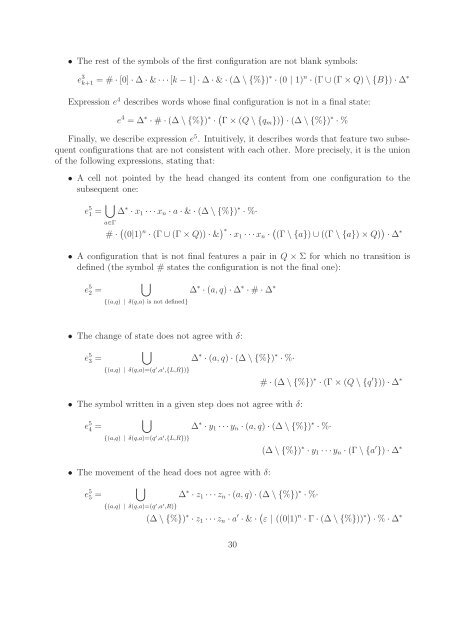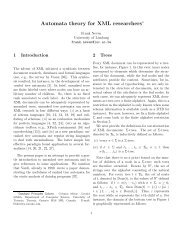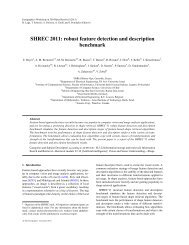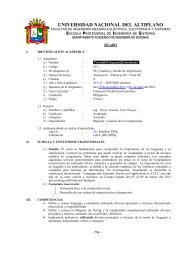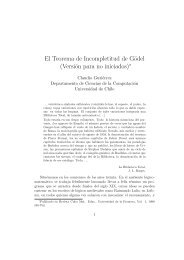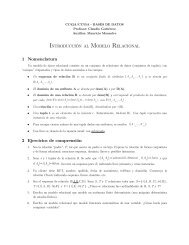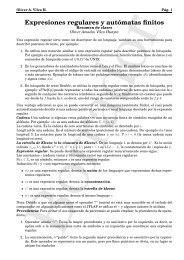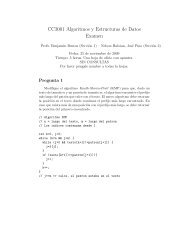• The rest of the symbols of the first configuration are not blank symbols:e 3 k+1 = #·[0]·∆·&···[k −1]·∆·&·(∆\{%})∗ ·(0 | 1) n ·(Γ∪(Γ×Q)\{B})·∆ ∗Expression e 4 describes words whose final configuration is not in a final state:e 4 = ∆ ∗ ·#·(∆\{%}) ∗ ·(Γ×(Q\{qm }) )·(∆\{%}) ∗ ·%Finally, we describe expression e 5 . Intuitively, it describes words that feature two subsequentconfigurations that are not consistent with each other. More precisely, it is the unionof the following expressions, stating that:• A cell not pointed by the head changed its content from one configuration to thesubsequent one:e 5 1 = ⋃ a∈Γ∆ ∗ ·x 1···x n ·a·&·(∆\{%}) ∗ ·%·#·((0|1) n ·(Γ∪(Γ×Q))·& )∗ ·x 1···x n ·((Γ\{a})∪((Γ\{a})×Q) )·∆ ∗• A configuration that is not final features a pair in Q × Σ for which no transition isdefined (the symbol # states the configuration is not the final one):e 5 2 =⋃{(a,q) | δ(q,a) is not defined}∆ ∗ ·(a,q)·∆ ∗ ·#·∆ ∗• The change of state does not agree with δ:e 5 3 =⋃∆ ∗ ·(a,q)·(∆\{%}) ∗ ·%·{(a,q) | δ(q,a)=(q ′ ,a ′ ,{L,R})}#·(∆\{%}) ∗ ·(Γ×(Q\{q ′ }))·∆ ∗• The symbol written in a given step does not agree with δ:e 5 4 =⋃∆ ∗ ·y 1···y n ·(a,q)·(∆\{%}) ∗ ·%·{(a,q) | δ(q,a)=(q ′ ,a ′ ,{L,R})}(∆\{%}) ∗ ·y 1···y n ·(Γ\{a ′ })·∆ ∗• The movement of the head does not agree with δ:e 5 5 =⋃∆ ∗ ·z 1···z n ·(a,q)·(∆\{%}) ∗ ·%·{(a,q) | δ(q,a)=(q ′ ,a ′ ,R)}(∆\{%}) ∗ ·z 1···z n ·a ′ ·&·(ε| ((0|1) n ·Γ·(∆\{%})) ∗)·%·∆ ∗30
e 5 6 =⋃(a,q) | δ(q,a)=(q ′ ,a ′ ,L)∆ ∗ ·w 1···w n ·(a,q)·(∆\{%}) ∗ ·%·#·(ε| ((∆\{%}) ∗ ·(0|1) n ·Γ·&) )·w 1···w n ·∆ ∗Having defined e M,ā , it is now straightforward to show that L ✸ (e M,ā ) = ∆ ∗ if <strong>and</strong> onlyif M does not accept on input ā. This finishes the proof of the Expspace lower bound. ✷Similarly to the nonemptiness problem (studied in Section 4.1), the Expspace boundfor Universality ✸ is quite resilient, as it holds even for simple expressions (note that itmakes no sense to study expressions of star-height 0, as they denote finite languages <strong>and</strong>thus cannot be universal).Proposition 7. The problem Universality ✸ remains Expspace-hard over the class ofsimple parameterized regular expressions.Proof: We sketch how to adapt the reduction of Theorem 6 to hold for simple parameterizedregular expressions (i.e. without repetitions of variables).Recall that the previous reduction used the alphabet {0,1,%,#,&}∪Γ∪(Γ × Q). Inthis case, we need a slightly bigger alphabet. Let ∆ = {0,1,&,# even ,% even ,# odd ,% odd } ∪Γ∪(Γ×Q). The idea is to modify the way configurations are represented.Previously, we had that runs of M were represented by words in the language:(#·[0]·(Γ∪(Γ×Q))·&···[2 n −1]·(Γ∪(Γ×Q))·&·% ) ∗.We modify the coding, so that configurations are represented in the following way:(#even ·[0]·(Γ∪(Γ×Q))·&···[2 n −1]·(Γ∪(Γ×Q))·&·% even·# odd ·[0]·(Γ∪(Γ×Q))·&···[2 n −1]·(Γ∪(Γ×Q))·&·% odd) ∗The intuition is that configurations using # even <strong>and</strong> % even represent an even step of thecomputation of the Turing machine, whereas configurations using # odd <strong>and</strong> % odd representan odd step. Notice that one can assume, without loss of generality, that the run of M overinput ā ends after an odd number of computations.All that remain to do is to adapt the definition of the expression e M,ā = e 1 | ··· | e 5 sothat it works under this modified coding, <strong>and</strong> such that e M,ā is simple. We omit most of thedetails, since most of the expressions in e 1 ,...,e 5 do not use parameters, <strong>and</strong> thus are notdifficult to modify.To see how the expressions using parameters can be modified so that they are simple,we show how to adapt the expression e 5 1 , that intuitively accepts all words describing twoconfigurations in which a cell not pointed by the head changed its content. It was definedpreviously ase 5 1 = ⋃ a∈Γ∆ ∗ ·x 1···x n ·a·&·(∆\{%}) ∗ ·%·#·((0|1) n ·(Γ∪(Γ×Q))·& ) ∗·x1···x n ·((Γ\{a})∪((Γ\{a})×Q) )·∆ ∗31


